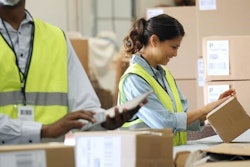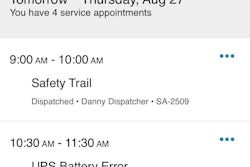
The 2020 holiday season is unlike any we’ve seen in history, but there’s one retail technology that remains constant—the barcode. 2020 marks 50 years since the introduction and commercialization of the Universal Product Code, more commonly known simply as a barcode. This symbol, with its 12-digit permutations, still appears on nearly every retail product across the world for digital cataloging and tracking.
The barcode is more relevant today than ever for consumers and retailers with the rise of alternative shopping methods and omnichannel fulfillment methods during the Coronavirus disease (COVID-19). The pandemic has propelled the adoption of curbside pickup, buy online/pick up in-store (BOPIS) and self-checkout shopping methods. In fact, 48% of global consumers have used in-store self-checkout during the pandemic or plan to in the future.
The barcode – and its scanners – have been key innovations in intelligent workflows for retail supply chains. They helped retailers reimagine the way work is done by provide visibility in managing inventory and automating a critical everyday tracking task. This intelligent workflow enabled information processing systems that affected nearly every consumer, enterprise and industry and fundamentally changed the way goods are bought and moved. Today, consumers have high expectations for personalized experiences and timely-delivered goods and services that wouldn’t be possible without the barcode.
Reinventing retail with digital automation
The grocery industry in post-war America was adapting to a boom in suburban supermarkets – seeking to automate checkout at stores to increase speed, drive down the cost of hiring too many checkout clerks and systematizing in-store inventory management. With the introduction of the barcode, the costs of checking out customers went down; the accuracy of transactions went up; checkouts sped up by some 40%; and in-store inventory systems dramatically improved management of goods on hand, on order or in need of replenishment. These technologies made it possible for all kinds of organizations, schools, universities and companies across industries to leverage the power of computers to manage their inventories.
As much as the barcode has been an important part of retail history, the data it amasses is also part of retail’s artificial intelligence (AI)-driven future. It’s a future where intelligent workflows will fuel data-driven smart supply chains. These reimagined ways of working embed AI and embrace automation where possible, and facilitate horizontal integration and adjustments across functions, providing 360-degree visibility of the supply chain and any potential disruptions. The advent of the barcode was a data structure stepping-stone toward the supply chain control tower, a critical digital platform with a personalized, connected command center of data capturing important business metrics and events.
COVID-19 and moving away from reactive, manually processed supply chains
The COVID-19 pandemic surfaced fractures in global supply chains due to simultaneous supply and demand shocks. Challenges that emerged from the pandemic required immediate action, forcing supply chain executives to re-chart their courses, with many resorting to short-term tactics like reallocating production lines to other products, rebalancing existing workforces, shutting down production and finding alternate logistics modes and providers to weather the storm. Dramatic changes in consumer behavior, cross-border trade challenges as well as sourcing and logistics challenges have revealed vulnerabilities.
What does the barcode mean for the future of supply chain? Today, though lack of end-to-end supply visibility and too much manual work remain to be challenges, fortunately, we’re at an important crossroads to address these issues. We’re in a better position for enterprises to re-engineer supply chain business processes into intelligent workflows with two key elements—an explosion of data and new emerging technology like AI, Internet of Things (IoT) and blockchain.
Intelligent workflows fuel the smarter supply chain of the future
COVID-19 has accelerated the urgency to revamp retail supply chains to move away from reacting to shocks and move toward using data and AI to anticipate and minimize future disruptions with flexibility and resiliency. Organizations need to leverage emerging technologies like artificial intelligence, hybrid cloud, robotics, automation, IoT, blockchain and edge computing with a holistic continuous intelligent planning approach. The barcode will remain an important aspect in this data driven revolution. These emerging technologies can help surface insights from disparate sources of structured and unstructured data to make better supply chain decisions in real-time.
The ability to identify and relentlessly fixate on real-time opportunities can be a game-changer, especially given the volatility of the COVID-19-era supply chain. In this new era, we have to think more about what customers need, and how to operate in volatile environments whether that’s a pandemic, a natural disaster or another black swan event. Companies and organizations need to use dynamic data from partners and external sources to see where products are—in real-time across the world—and turn this data into actionable insights that can predict and respond to potential disruptions. As we move forward, we cannot fully predict the parameters of a post-pandemic future, but intelligent workflows can help build a smarter, more resilient global supply chain and narrow the gap between the expected and unexpected.
During this 2020 holiday season, supply chains across industries strategized for the future by rethinking how they adopt intelligent workflows in the future. A smarter supply chain – one that uses intelligent workflows fueled by data-driven decisions – is an effective strategy that can adapt to rapidly shifting environments. The future smarter supply chains continue to not just embrace automation with the help of the barcode, but also use AI to make processes more efficient, responsive and adaptive. The barcode has withstood the test of time because it continues to serve a key role in the evolving digital future of retail where the data it captures will shape decisions affecting customers and retailers.
















